Exposing Caesarea's Hidden Treasures and Upgrading the Tourism Product
The Edmond de Rothschild Foundation, Caesarea Development
Corporation, Israel Antiquities Authority and Israel Nature and Parks Authority announced cooperation on an unprecedented scale in exposing,
conserving and making accessible the important public buildings of ancient
Caesarea in Caesarea National Park, and developing and making the settlement’s
beaches accessible. This involves an overall investment of more than 100
million NIS that were allocated for the project by the Edmond de Rothschild Foundation
and the Caesarea Development Corporation.
The Ancient Caesarea Renewal Project was announced to the
public at a press conference that took place in Caesarea National Park,
with the participation of
Guy Swersky, vice chairman of the Edmond de Rothschild Foundation,
Michael Karsenti, CEO of the Caesarea Development Corporation, Shaul
Goldstein, director-general of the Israel Nature and Parks Authority and Dr.
Doron Ben-Ami, the IAA Central Region archaeologist.
The renewal project
enhances and upgrades the visitor’s experience in Caesarea National Park as the
foremost antiquities site in Israel, together with Jerusalem. The project is being
implemented as part of realizing the vision of 3 million tourists in Caesarea
by the year 2030, and is becoming an important tourist-economic anchor for the
residents of the region.
One of the unique features of the project is the support
of the general public – pupils from Or Akiva, cadets, students and ordinary
citizens who come to volunteer and take part in the archaeological excavations
at the various sites throughout Caesarea – turning Caesarea's fascinating past
into a glorious future for the entire region.
Caesarea has been a vibrant port city since its
establishment about 2,030 years ago and throughout the various ensuing periods.
Its importance and architectural wealth made it one of the premier cities in
the Roman and Byzantine Empires. The archaeological excavations that are being
conducted at the site in recent years on behalf of the Israel Antiquities
Authority, which are a continuation of the excavations
Together with the large-scale archeological excavations,
extensive conservation and restoration measures and development of the harbor
are taking place in Caesarea National Park. In fact, this is one of the largest
and most important conservation projects ever undertaken in Israel. There is no
other site in Israel where in recent years so many funds, resources and means
of conservation and development have been allocated. This is a complex
operation, which poses many challenges in planning and execution, while
maintaining the values of the place. The project is being directed by conservator
Yoram Sa'ad and architect Ya'ara Shaltiel of the IAA Conservation Department.
Upon completion of these activities the Caesarea Development Corporation and Israel
Nature and Parks Authority will construct an innovative visitor center, installations
for benefit of visitors, a spectacular archaeological park and an enchanting
promenade that will begin at the ancient aqueduct (Aqueduct Beach) and connect
to the city wall and fortifications promenade of ancient Caesarea.
Guy
Swersky, vice chairman of the Edmond de Rothschild Foundation noted, “Since its
establishment the Edmond
de Rothschild Foundation has contributed hundreds of millions of shekels to the
advancement of higher education in Israel and has been at the forefront of
innovative initiatives throughout the country. The foundation made a strategic
decision to invest more than NIS 100 million in uncovering the layers of
history and exposing the fascinating past of ancient Caesarea. This enormous
project has unprecedented archaeological significance, but it is no less
important as a catalyst for tourism and economic activity that will benefit the
entire region. The wealth of artifacts already discovered in the excavations
greatly enhances one’s experience when visiting the national park and Caesarea’s
harbor, and provides a rare glimpse into the historical story of Caesarea as
the Roman and
Byzantine capital, and as an
mportant rabbinic center for generation. The ancient Jewish past of
the city, of Rabbi Akiva and the ten martyrs is revealed before our very eyes".
Michael
Karsenti, CEO of the Caesarea Development Corporation adds, “For the
first time, the three relevant entities –
the Israel Antiquities Authority, Israel Nature and Parks Authority and
Caesarea Development Corporation –
are working together to implement a plan that will ensure the meticulous preservation
of the archaeological, historical and nature values of Caesarea throughout all
of the periods, along with making them easily accessible to the vast visiting public
from Israel and the world. These works include exposing, conserving and making
accessible the Old City and its treasures to visitors from Israel and abroad.
We are meticulous about maintaining the "Caesarea Standard" – the
highest level of planning and execution, as is customary in all activities undertaken
by the Caesarea Development Corporation. The aim is to enrich and expose the
centers of archaeological, cultural and religious content throughout ancient
Caesarea – from Jisr az-Zarqa in the north by way of the aqueduct, the ancient
harbor, to Kibbutz Sdot Yam and the Odeon – and turn them into the main tourism
site in Israel, together with Jerusalem. This is a comprehensive development
momentum that will change the reality and transform the entire area into an
international tourist destination”.
According to Shaul Goldstein, director general of the Israel
Nature and Parks Authority, “It was in Caesarea that Hannah Szenes wrote
the prayer ‘My God, My God, I pray that these things never end…the prayer of
Man’. Szenes’ poem is a continuation of the prayers that were uttered in
the ancient synagogue from the time of the Second Temple, that is identified
with Rabbi Akiva, who said ‘Love
your fellow as yourself which is a great
principle of the Torah’ and was among the ten martyrs murdered by the
Romans. As part of the project, the synagogue will be partially renovated and it
will be permitted to hold ceremonies there. The launching of this exciting
project, particularly during the period of national memorial days, symbolizes
the connection to the roots and history of the people and this land. Caesarea
was an important port city, a gateway to world culture in the Land of Israel.
We are extremely pleased with the excellent cooperation that we have with the other
parties and hope that the site will continue to attract a great many travelers.
The Israel Nature and Parks Authority is working to develop the heritage sites
in Israel, and this project is an important element in the discovery of
additional parts of the story of the Land of Israel”.
According to the Israel Antiquities Authority director
Israel Hasson, “The joint project is meant to expose, conserve and make
use of Caesarea’s secrets for the enjoyment of the general public. To date,
only about six percent of Caesarea's treasures have been discovered, and
magnificent finds on a global scale are buried beneath its sand dunes. This
initiative must be a springboard for an ongoing national project to develop the
Caesarea site in all its glory. It should be noted that beyond the
archaeological activity, groundbreaking conservation measures are being carried
out led by the IAA Conservation Department. We consider this project an
opportunity for fostering educational activities at the regional and national
levels, and invite the public and discharged soldiers to come, work, volunteer,
and be partners in this creative effort”.
A number of significant archaeological discoveries
and conservation measures were presented for the first time at the press
conference:
A system of vaults in the front of the "temple platform"
built by King Herod:
At the center of the excavation and conservation activity
is the impressive façade of the main public building of Caesarea from 2,030
years ago - the sacred precinct (temenos) that Herod built in Caesarea
as a tribute to his patron Augustus, emperor of Rome, and to the goddess Roma.
In his book The Wars of the Jews (I:408–414) Josephus describes the
construction of the Temple of Augustus and Roma, which looked out over the sea.
According to him, Herod built the temple at the top of the hill, and its size
and appearance were wonderful. Inside the temple stood a huge statue of the
emperor in the image of Olympian Zeus, and another statue of the goddess Roma,
in the image of Hera of Argos. These sculptures have yet to be found in the
excavation, and they may have been taken from the site in later periods. The
hill mentioned by Josephus is actually an extensive artificial platform that is
even evident in the area today, measuring about thirteen dunams. Archaeologists
refer to this elevated area as the temple platform.
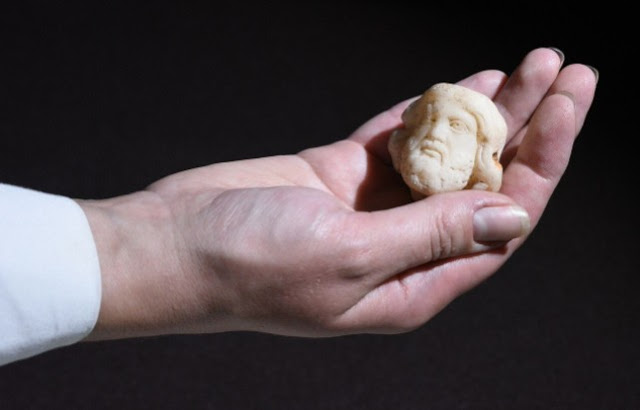

In the most recent excavations, directed by Dr.
Peter Gendelman and Mohammed Hater on behalf of the Israel Antiquities
Authority, an impressive system of vaults was revealed that stood in the
western facade of the temple platform. “This façade included two halls (20
× 25 m) whose western side was open to the harbor, each of which was covered by
four vaults. An array of smaller vaults constructed between the two halls supported
a monumental staircase which led visitors from the harbor to the sacred precinct.
One of the country’s largest conservation and development projects of an
archaeological monument is being carried at the site. After the vaults are
completely stabilized and
restored by the staff of the IAA Conservation Department,
the site's main visitor center will be built inside them, which will tell the
story of Caesarea over the years.
Recently, a rare and important discovery was revealed
at the front of the temple - the foundation of a large stone altar that stood
in an enclosure, open to the sky, similar to Augustus’ peace altar, the Ara
Pacis, located in Rome. This altar was used for sacrifices offered in
honor of Emperor Augustus.
The foundations of other smaller altars were exposed
alongside the main altar. According to the excavators, dozens of deep holes
that were exposed in the excavation around the main altar were intended to hold
torches or standards (symbols of the Roman legion carried by soldiers on
poles). Josephus relates that when the Roman army burst into the Temple Mount,
the soldiers set their standards up opposite the eastern gate, offered up
a sacrifice and proclaimed Titus imperator (victor).
According to researchers Gendelman and Hater,
"It is possible that the legionnaires in Caesarea also left their
standards at the altar when they offered a sacrifice honoring the emperor in
his temple. All these reflect the strong ties that existed between Caesarea and
Rome, which spread its patronage over Herod’s city, and the ceremonies that
were held at Caesarea in honor of Emperor Augustus and the goddess Roma”.
A major change in the sacred precinct occurred at the
end of the fifth century CE, during the Byzantine period. An octagonal church
was erected on the foundations of the Temple of Augustus and Roma. The altar
built by Herod was dismantled, and a new entrance and staircase were constructed
that connected the pier to the church. New vaults that served as storerooms
were built on the foundations of the arched Herodian hall. With the
establishment of Muslim Caesarea on the ruins of Roman and Byzantine Caesarea
in the ninth and tenth centuries CE, some of the buildings that were still
standing were reused, and new structures were erected in adjacent areas.
The ancient synagogue in Caesarea was first
discovered in the 1940’s. Archaeological excavations at the site revealed
artifacts that attest to the presence of a synagogue from the Byzantine period,
some 1,500 years ago. Among the finds that were exposed are column capitals
adorned with menorah symbols, mosaics and inscriptions, including a dedication
to donors and fragments of an inscription of the twenty-four priestly
divisions. Synagogues were built in Caesarea since the time of Herod. In his
book The Wars of the Jews, Josephus describes the desecration of a
synagogue in Caesarea, which led to the outbreak of the Great Revolt in 66–70
CE. In the Talmud there is also a story about the “kenista d'mardata”
(the synagogue of the revolt). It is also known that after the Romans
suppressed the Bar Kokhba revolt (132-136 CE), Rabbi Akiva was brought to trial
in Caesarea, and he was executed as one of the ten martyrs. Development work
slated to be done at the site of the ancient synagogue will include conserving
the remains, reconstructing the synagogue’s mosaic and making the site
accessible to the general public, while content that is related to the Jewish
heritage of ancient Caesarea will be presented there.
The Crusader market. Impressive remains of a vibrant
market place that existed in Caesarea during the Crusader period, more than 700
years ago, were revealed in an
excavation conducted by Dr. Uzi ʽAd, Dan Kirzner and Mohammad Hater on
behalf of the Israel Antiquities Authority, in the eastern part of the temple
platform. The ground floor of the buildings that were exposed were occupied by
shops and their first floor was used as dwellings. Some of the rooms were paved
with colorful mosaics; others were covered with marble slabs.
A spectacular fountain (nymphaeum) from the
Roman period. A public fountain was built in the northwestern corner of the
temple platform in the first century CE. The walls of the nymphaeum and
the pool were treated with plaster and covered with paintings, and marble
statues were placed in its three niches. The fountain was re-exposed in 2014
and the IAA Conservation Department carried out restoration work of the channel
around the pool and the waterworks there.
Other Special Finds:
The excavations in Caesarea in recent years have yielded
interesting finds, including parts of marble statues, granite and marble capitals
and columns, two of which bear inscriptions and drawings, coins, pottery vessels,
stone objects and metal and bone items etc.
A very important find that was just discovered
recently while conserving the vaults attests to the Jewish life that existed in
Caesarea since the city was founded by Herod 2,000 years ago: a tiny mother-of-pearl
tablet engraved with a seven-branched candelabrum and a coal pan. During
the Middle Roman and Byzantine periods Caesarea was an important Jewish center,
and the Jews were an integral part of the economic and social system of this
multicultural city.
Another important find that was discovered in the Caesarea
excavation project is a statue of a ram that was found next to the vaults in
the façade of the temple platform. In Christian art the ram is often
depicted carried on the shoulders of the “Good Shepherd” (that is,
Jesus, who is portrayed as the shepherd tending his flock), and
sometimes the ram is situated alongside of Jesus. The statue might have been
part of the décor in the octagonal church from the sixth–seventh centuries CE
at Caesarea. By the same token it could also be earlier, from the Roman period,
and was incorporated in secondary use in the church structure”.
Still another interesting find is a carved marble fragment
of a figurine of the head of a bearded man from the Roman period. According
to Dr. Rivka Gersht of the Department of Classical Studies at Tel Aviv
University, "The 2,000 year old head depicts Asclepius, the god of
medicine. Asclepius and his daughter Hygieia, goddess of health, were of great
importance in Roman and Byzantine Caesarea. It is interesting to note that
several statues of Asclepius have been found so far in Caesarea, but this is
the first time that his head has survived”.


My Hebrew sites:

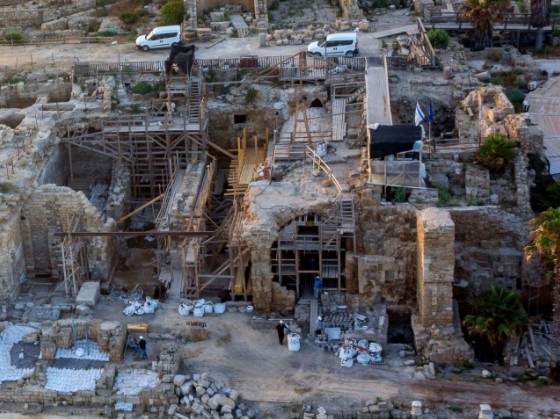
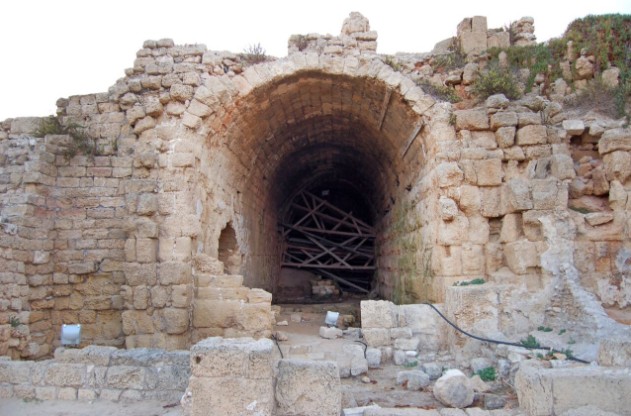

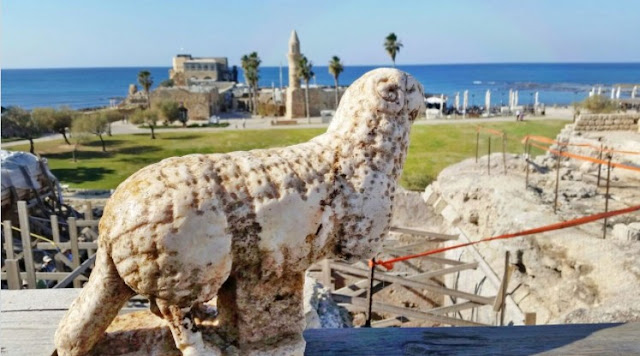



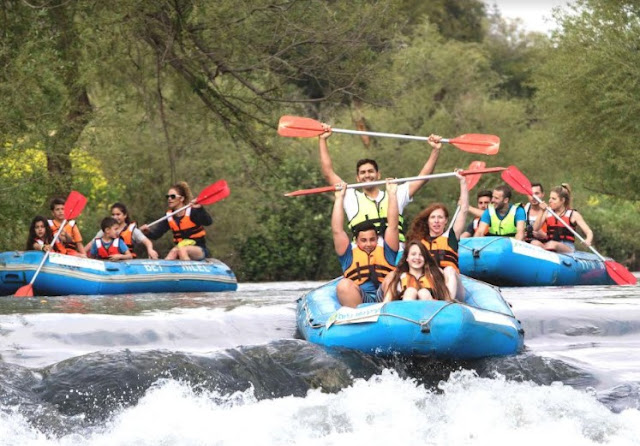
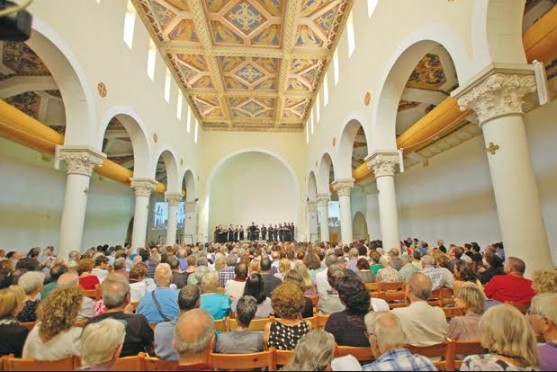

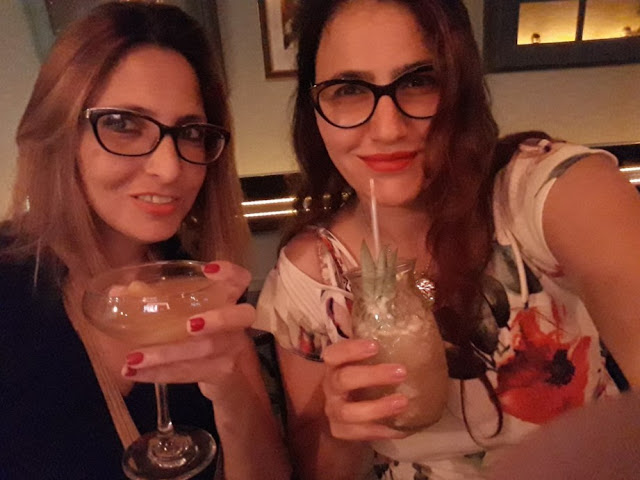
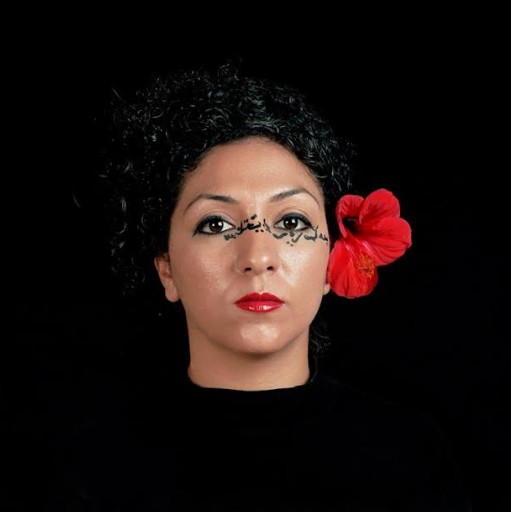

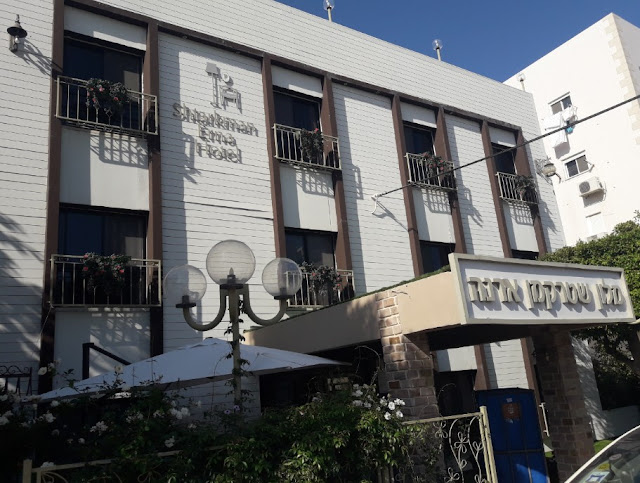
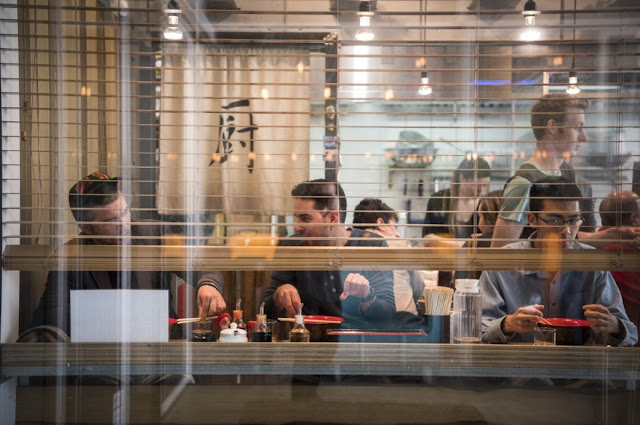

Comments
Post a Comment